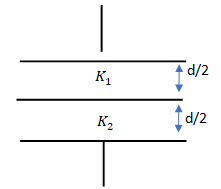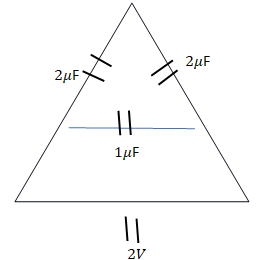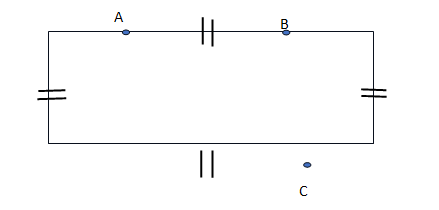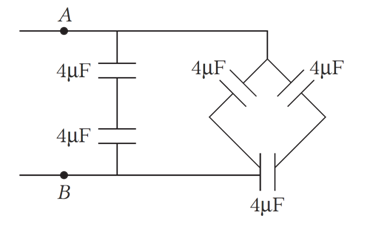NEET Physics
Electrostatic Potential and Capacitance


Question 1.
The electric potential at point A is 40 V and at B is – 80 V. Find the work done by an external forces and electrostatic force in moving an electron slowly from B to A.
Question 2.
What is the electrostatic potential at the surface of a silver nucleus of diameter 12.4 fermi? Atomic number (Z) for silver is 47.
Question 3.
Three point charges 1 C, 3 C and -5C are placed at (1m,0,0), (0,2m,0) and (0,0,3m) respectively. Find the electric potential at origin.
Question 4.
An electric dipole consists of two charges of equal magnitude and opposite sign separately by a distance 2a as shown in figure. The dipole is along the x-axis and is centered at the origin
1. Calculate the electric potential at point P.
2. Calculate V at a point far from the dipole.
Question 5.
An electric field E = (20i+30j)newton/coulomb exists in the space. If the potential at the origin is taken to be zero, find the potential at (3m, 3m).
Question 6.
Two plates are 2 cm apart a potential difference of 10 V is applied between them, the electric field between the plates is
A. 20
B. 500
C. 5
D. 250
Question 7.
A hollow metal sphere of radius 6 cm is charged so that the potential on its surface is 20V. The potential at the centre of the sphere is
A. 0 V
B. 20 V
C. Same as at point 6 cm away from the surface
D. same as at point 25 cm away from the surface
Question 8.
A ball of mass m having a charge q is released from rest in a region where a horizontal electric field E exists.
(i) Find the resultant force acting on the ball.
(ii) Find the trajectory followed by the ball.
Question 9.
Identify the wrong statement.
A. The electrical potential energy of a system of two protons shall increase if the separation between the two is decreased
B. The electrical potential energy of a proton-electron system will increase if the separation between the two is decreased
C. The electrical potential energy of a proton-electron system will increase if the separation between the two is increased
D. The electrical potential energy of system of two electrons shall increase if the separation between the two is decreased
Question 10.
Two parallel plate of area A are separated by two different dielectrics as shown in figure. The net capacitance is

A.
B.
C.
D.
Question 11.
There is an air filled 1pF parallel plate capacitor. When the plate separation is doubled and the space is filled with wax, the capacitance increases to 2pF. The dielectric constant of wax is
A. 2
B. 4
C. 6
D. 8
Question 12.
Three capacitors each of capacitance C and of breakdown voltage V are joined in series. The capacitance and breakdown voltage of the combination will be
A. C/3, V/3
B. 3C, V/3
C. C/3, 3V
D. 3C, 3V
Question 13.
The charge on anyone of 2μ F capacitors and 1 μ
F capacitors and 1 μ F capacitor will be given respectively (in μ
F capacitor will be given respectively (in μ C) as
C) as
A. 1,2
B. 2,1
C. 1,1
D. 2,2

Question 14.
The potential energy of a charged parallel plate capacitor is . If a slab of dielectric constant K is inserted between the plates, then the new potential energy will be
A.
B.
C.
D.
Question 15.
For capacitors each of capacity 3μ F are connected as shown in the following figure. The ratio of equivalent capacitance between A and B and between A and C will be
F are connected as shown in the following figure. The ratio of equivalent capacitance between A and B and between A and C will be

A. 4 : 3
B. 3 : 4
C. 2 : 3
D. 3 : 2
Question 16.
There are 7 identical capacitors. The equivalent capacitance when they are connected in series is C. The equivalent capacitance when they are connected in parallel is
A. C/49
B. C/7
C. 7C
D. 49C
Question 17.
Charge Q on a capacitor varies with voltage V as shown in the figure, where Q is taken along the X-axis and V along the Y-axis. The area of triangle OAB represents
A. Capacitance
B. Capacity reactance
C. Electric field between the plates
D. Energy stored in the capacitor

Question 18.
The displacement of a charge Q in the electric field is
. The work done is
A. Q(a + b
)
B.
C.
D.
Question 19.
Three equal capacitors, each with capacitance C are connected as shown in figure. Then the equivalent capacitance between point A and B is

A. C
B. 3C
C. C/3
D. 3C/2
Question 20.
The equivalent capacitance between points A and B in the circuit will be

A. 10/3 μ F
F
B. 4 μ F
F
C. 6 μ F
F
D. 8 μ F
F
**********
In summary, problem-solving after learning a theoretical concept on CBSE Electrostatic Potential and Capacitance NEET Physics is an essential part of the learning process. It enhances your understanding, critical thinking abilities, and retention of knowledge. Moreover, it equips you with valuable skills that are applicable in academic, personal, and professional contexts.
You must have heard of the phrase “Practice makes a man perfect”. Well, not just a man, practice indeed enhances perfection of every individual.
Practicing questions plays a pivotal role in achieving excellence in exams. Just as the adage goes, "Practice makes perfect," dedicating time to solve a diverse range of exam-related questions yields manifold benefits. Firstly, practicing questions allows students to familiarize themselves with the exam format and types of problems they might encounter. This familiarity instills confidence, reducing anxiety and improving performance on the actual exam day. Secondly, continuous practice sharpens problem-solving skills and enhances critical thinking, enabling students to approach complex problems with clarity and efficiency. Thirdly, it aids in identifying weak areas, allowing students to focus their efforts on improving specific topics. Moreover, practice aids in memory retention, as active engagement with the material reinforces learning. Regular practice also hones time management skills, ensuring that students can allocate appropriate time to each question during the exam. Overall, practicing questions not only boosts exam performance but also instills a deeper understanding of the subject matter, fostering a holistic and effective learning experience.
All About Daily Practice Problems on NEET Physics Electrostatic Potential and Capacitance NCERT Chapter 2
Our Daily Practice Problems (DPPs) offer a diverse range of question types, including Multiple Choice Questions (MCQs) as well as short and long answer types. These questions are categorized into Easy, Moderate, and Difficult levels, allowing students to gradually progress and challenge themselves accordingly. Additionally, comprehensive solutions are provided for each question, available for download in PDF format - Download pdf solutions as well as Download pdf Questions. This approach fosters a holistic learning experience, catering to different learning styles, promoting self-assessment, and improving problem-solving skills. With our well-structured DPPs, students can excel in exams while gaining a deeper understanding of the subject matter. Hope you found the content on NEET Physics Electrostatic Potential and Capacitance NCERT Chapter 2 useful.
Last but not least, to get the best hold on NEET Physics Electrostatic Potential and Capacitance NCERT Chapter 2, do not forget to check out: